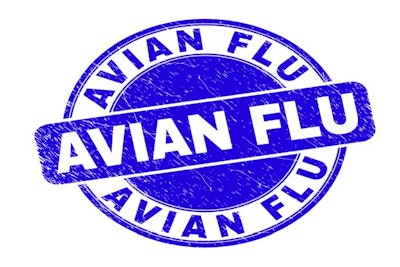
The World Organisation for Animal Health (OIE) has been notified by Russia’s animal health authority about new outbreaks of highly pathogenic avian influenza (HPAI) in poultry in the Ural federal district.
The latest cases include the first ever reported occurrence of HPAI in the Sverdlovsk region.
Here, an H5 HPAI virus was detected in a backyard flock of 250 poultry in early October. More than 140 of the birds died.
In the first half of October, eight new outbreaks were confirmed in the neighboring region of Tyumen. In six different districts of this region, backyard flocks — each with between 25 and 309 poultry — tested positive for the H5N1 HPAI virus variant.
In this outbreak series in Tyumen, the number of outbreaks among non-commercial poultry and wild birds since June of 2021 has reached 11. These involved more than 1,600 birds. Also recorded are two mass mortalities among wild pelicans.
On October 10, poultry tested positive for an H5 HPAI virus in a commercial flock of more than 1.67 million birds in the Tyumen region. That was the region’s first confirmed outbreak at a commercial premises since January of this year.
Three new outbreaks in Taiwan
Between mid-August and the end of September, the H5N5 variant of the HPAI virus was detected at three location in Taiwan.
According to the latest report from the territory’s veterinary agency to the OIE, affected were a group of native chickens at a Taipei slaughterhouse, and poultry at two farms in Yunlin county. Affected were a flock of more than 18,000 broiler breeders — 490 of which died — and around 2,400 meat ducks.
Since this HPAI virus strain was first detected in Taiwan in September of 2019, its presence has been detected at 73 locations. Almost 595,000 poultry have lost to the disease through mortality or culling.
China records 50 human infections with H5N6 influenza
Over the past week, two new cases of avian influenza A(H5N6) in China have been reported by the Centre for Health Protection in Hong Kong.
First was a 66-year-old man from Yongzhou in Hunan province. A farmer with known contact with poultry, he had been taken ill one month previously. His condition was still considered to be critical.
Two days later, the same source reported that a 52-year-old man had tested positive for the same virus type. From Dongguan in Guangdong province, the patient worked at a market, selling live domestic poultry. His condition was described as “critical” on October 29.
Since 2014, 50 human cases with this influenza virus type have been reported by the health authorities of mainland China.
Of these cases, 20 have been confirmed since June of 2021. Three deaths have been recorded, and the condition of all the other patients was described as “serious” or “critical” at the time of reporting. Majority of them were aged 40-70, and had contact with live domestic poultry — either on their own farm, or at a market.
More HPAI outbreaks in commercial birds in South Africa
Since March of this year, the number of confirmed outbreaks of HPAI linked to the H5N1 virus variant in South African farms has risen to 63. These have directly impacted almost 3.38 million birds, according to notifications to the OIE.
Latest to be reported are outbreaks on three farms. In the first week of October, poultry tested positive for this virus at two locations in KwaZulu-Natal. Affected flocks comprised 530 and 650 birds of unspecified type, including around 570 mortalities.
Also recently reported but dating back to early July was an outbreak in a commercial ostrich flock in Western Cape. Of the 1,648 birds at the premises, nine tested positive for the virus, and three died.
Endangered Cape cormorant population under threat
Concerns are being expressed at the continuing mortality of Cape cormorants in South Africa.
According to a recent report in The Citizen, 12,000 of these birds are known to have died already. Losses have been particularly high among the chicks hatched in this breeding season.
A local wildlife expert said this amounts to around 5% of the remaining population of this endangered species. Daily mortality is known to be around 500, and could be much higher. Along the coast from South Africa to Mozambique are thought to be around 234,000 adult birds of the species.
Latest report to the OIE from South Africa’s animal health agency includes mortalities of almost 9,000 of these birds linked to the H5N1 HPAI virus. A further 334 of the birds have been culled.
In the same outbreak series, OIE was notified of a further outbreak in a backyard flock of 130 poultry in KwaZulu-Natal. More than 50 of the birds died.
Since March, the country’s veterinary authority has notified the OIE about a total of 103 outbreaks of HPAI in poultry (both commercial and backyard flocks), and wild birds.
Another HPAI outbreak in Ghana
In the Greater Accra region near the Ghanaian capital, more than 850 poultry have been destroyed at a farm.
The affected premises, ETY Farms, has been disinfected and fumigated, reports News Ghana. The farm is located in Saki, which is in the municipality of Kpone-Katamanso.
In July, the West Africa nation’s veterinary authority officially registered with the OIE seven HPAI outbreaks linked to an H5 virus. Affected were a total of almost 9,600 poultry in the Greater Accra and Central regions.
Since that time, OIE has not been notified of any new outbreaks. However, local media in Ghana have reported cases also in the regions of Ashanti, Volta, Western, Western North, and Upper West.
Over the past year, the United Nations’ Food and Agriculture Organization (FAO) has recorded six HPAI outbreaks in Ghana in domestic birds. According to the national veterinary service, presence of the H5N1 HPAI virus variant has been detected, but FAO awaits official confirmation of this finding.
View our continuing coverage of the global avian influenza situation.

















